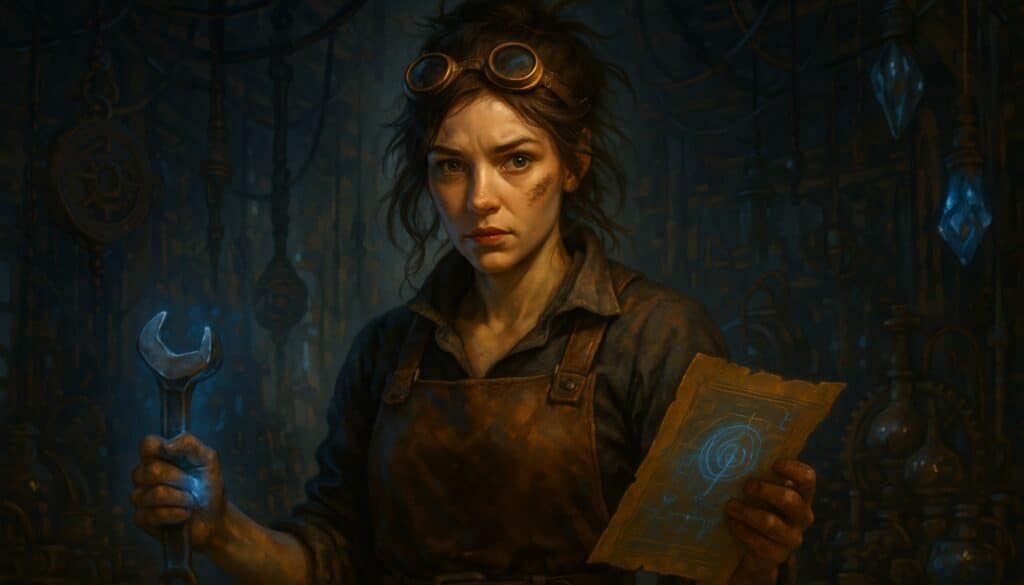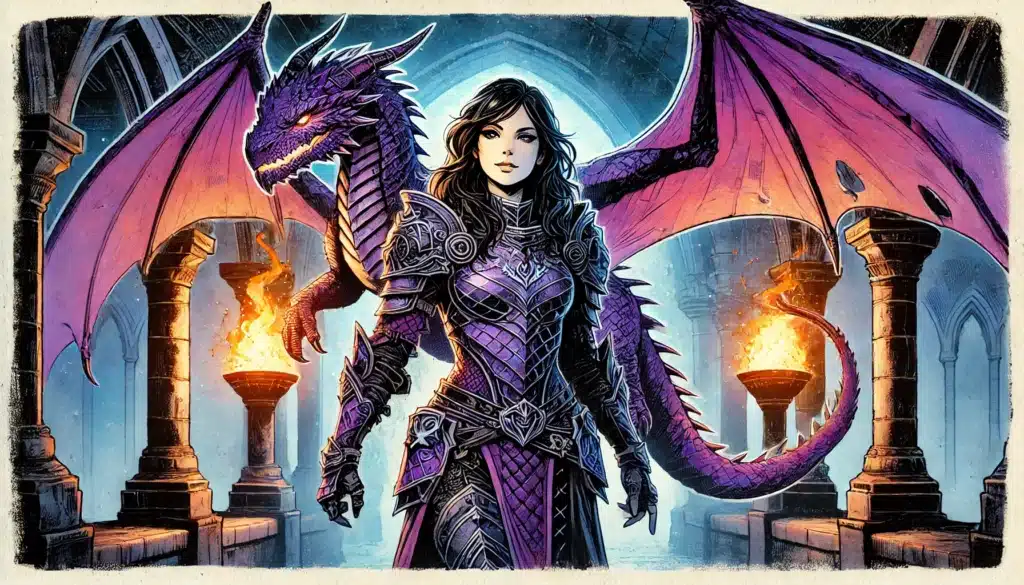The moment you sit down to create your first Dungeons & Dragons character, you’re confronted with a dizzying array of choices, each promising a unique journey through the realms of high adventure. While every class can light up the imagination and deliver a satisfying tabletop experience, not all stand on equal footing when it comes to easing new players into the grand tapestry of D&D 5e. For those still finding their footing, certain classes burden newcomers with convoluted mechanics, bloated decision trees, and arcane rules that can feel more like stumbling blocks than stepping stones.
Class difficulty in D&D 5e isn’t just about low hit points or how hard a character can hit with their sword. The real hurdles manifest in the quiet nightmare of managing complex spell systems, the silent pressure of making impactful choices with little experience to guide them, and the weight of grasping multitudes of subtle rules before even rolling initiative. It’s one thing to read an exciting class description. It’s quite another to realize, several sessions deep, that the class asks far more of you than you bargained for.
That isn’t to say these challenging classes can’t be a blast for the right player. In the hands of a seasoned veteran, a mechanically intricate class is a playground of possibility, brimming with hidden tactics and powerful combinations waiting to be discovered. But for those new to the world of initiative rolls and ability checks, such choices can lead to confusion, discouragement, and the sense that everyone else is “doing it right” while you flounder in a pool of miscast spells and missed opportunities.
It’s crucial to clarify: none of the classes on this list are “bad” or poorly designed. Each offers something special to the D&D experience, with stories and moments that leave lasting memories. The issue is not inherent to the classes themselves but rather the sheer learning curve they demand. New players, still learning the basics of roleplay, combat, and collaboration, are often better served by classes with forgiving mechanics and straightforward playstyles. This guide explores which classes beginners may want to avoid until they’ve got a couple of quests under their belts—and why.
What Makes a Class Bad for Beginners
Some classes seem tailor-made to trip up uninitiated adventurers. At their core, these “unfriendly” options layer complexity atop complexity, demanding an understanding of intricate subsystems and advanced strategies just to keep pace with the group. Take the spellbook-toting wizard or the adaptable druid—both can wield immense power, but only at the cost of tracking concentration spells, memorizing vast spell lists, and making choices that can ripple through an entire session. If you don’t know the difference between a bonus action and a reaction, or what “material components” even are, you’re in for a rough ride.
Another major pitfall is the requirement for system mastery. Certain classes rely on nuanced rule interactions or deep mechanical knowledge to thrive, making it all too easy for a beginner to feel lost or ineffective. Some classes shine only when built and played with long-term synergy in mind, meaning a poor decision at level one can leave a character feeling awkward or unsatisfying five levels later. For those still grappling with the core rules, adding another layer of strategy can overwhelm rather than inspire.
Try my AI Tabletop RPG generators...and an extensive library of content!
Of course, there are always the rare beginners who relish an uphill climb, hungry for challenge from their very first d20 roll. For most, though, starting with a difficult class can mean frustration, missed opportunities, and a sense of lagging behind more experienced players. The most fun is found in engaging with the story, the table, and your fellow adventurers—not trying to remember whether you’ve already used your reaction this round, or worrying if you picked the wrong spells at dawn. A class that’s too demanding can sap joy from the game before it even truly begins.

#1: The Druid
For those lured by the promise of shape-shifting, elemental power, and the earthy mystique of the Druid, it’s easy to get swept up in all the possibilities. But beneath this enchanting veneer lies a class that can quickly turn into a logistical labyrinth for first-time players. The Druid’s Wild Shape ability alone is a whole subsystem unto itself, asking players to memorize not only beast stat blocks but also how their features interact (and sometimes conflict) with those forms. Keeping track of which animals you can become, what abilities carry over, and what actions are even possible in each form can bog down play just as much as it spices it up.
Spellcasting, especially in the Druid’s hands, layers on even more complexity. Unlike classes that just “know what they know,” Druids prepare spells freshly each day from a broad, often overwhelming list. This means that every morning in-game, a Druid player must assess the day’s likely encounters, environmental obstacles, and tactical needs. Making the wrong call can leave you with a toolkit that just doesn’t fit the adventure ahead—a frustrating lesson in foresight that’s tough to master without experience.
Role ambiguity is another hurdle. The Druid seems to offer everything: powerful spells, robust healing, and tankiness while wild-shaped. But playing to all these strengths at once requires a nuanced understanding of when to step up as a frontline bruiser versus when to hang back and sling spells. For beginners, this almost paradoxical flexibility can lead to hesitation or a diluted identity in the party, especially when everyone else is happily swinging swords or casting familiar fireballs.

Fantasy RPG AI Generators with ChatGPT+
Make life as a Game Master easier.... If you play Dungeon & Dragons, Pathfinder, or other fantasy tabletop role-playing games, check out my DND character backstory generator and other fine AI RPG tools at LitRPG Adventures Workshop today.
Layer these issues together, and you have a class that expects a new player to be part tactician, part nature-theorist, and part magician, all while keeping an eye on the shifting sands of group dynamics. The Druid can reward mastery handsomely, but for many stepping into the hobby, it simply heaps on too much, too soon.
Ten+ Reasons Druid is Hard for New Players:
- Wild Shape requires memorizing multiple beast stat blocks and tracking their abilities.
- Must prepare spells daily from a broad and ever-changing list.
- Needs to understand concentration mechanics to avoid costly mistakes.
- Balancing spellcasting and melee/tank roles can be deeply confusing.
- Managing spell components and environmental limitations is not intuitive.
- Environmental adaptability often requires meta-game knowledge.
- Many Druid spells have unique or situational effects, making choices tricky.
- Some features, like Circle abilities, add yet another layer of decision-making.
- Mistakes with daily spell preparation can lead to entire sessions feeling underpowered.
- Wild Shape can drastically change “what you can do” multiple times per game.
- Animal forms may limit communication, spell use, or party synergy until mastered.
- Some Druid circles (like Shepherd or Moon) introduce advanced buffs or form management.
- Requires frequent reference to multiple rulebooks or resources during the game.

#2: The Monk
At first glance, the Monk seems tailor-made for new adventurers—swift, self-sufficient, and evocative of every martial arts legend. In practice, though, this class is a puzzle box that new players often regret opening. The Monk’s defining feature, Ki, introduces a unique resource pool that resets each short rest but evaporates quickly in play if not carefully conserved. Tracking how much Ki you have, what each ability costs, and when to use those points means a constant inner calculus that can be unforgiving if mismanaged.
Monks are also heavily reliant on mobility and precise positioning. More than most classes, their effectiveness hinges on darting in and out of combat, using hit-and-run tactics, and always considering their place on the battlefield. For a beginner, simply moving on a gridded map can be confusing—add in abilities that boost movement, jump distance, or allow movement along vertical surfaces, and things quickly spiral into complexity.
Another challenge lies in their “lighter than air, lighter than gear” nature. Monks thrive without armor, depending on high physical stats and clever choices. But they don’t always hit hard enough to make up for their relative fragility, especially at lower levels. New players might find themselves taking risks and getting knocked out, unsure of why their acrobatic prowess doesn’t keep them safe.
Finally, the Monk’s flavor often teases magical or mysterious powers, but mechanically, they lack the spell repertoire of sorcerers or wizards. This disconnect can be disheartening when a new player expects to leap across rooftops, channel energy, or blend mystical attacks with martial prowess—only to realize that most of their options are less spectacular than imagined, especially early on.
Ten+ Reasons Monk Can Frustrate Beginners:
- Ki system adds complex resource management on top of regular actions.
- Movement-based abilities require precise understanding of positioning.
- Low hit points and lack of armor can lead to repeated knockouts.
- Action economy is confusing, especially with Flurry of Blows or movement features.
- Many Monk abilities have specific limitations (e.g., only when unarmored).
- Lack of spells can be disappointing given the class’s mystical vibe.
- Some subclasses introduce even more abilities to track and time correctly.
- Requires good Dexterity and Wisdom scores to function, limiting build variety.
- Many features rely on DM flexibility for cool moments (like wall-running).
- Poor damage scaling compared to other martial classes at higher levels.
- Subtle, timing-based decision making can be lost on new players.
- Reliance on short rests may not click with some groups’ playstyles.
- Early level power feels underwhelming compared to simpler martial classes.

#3: The Artificer
Few classes in Fifth Edition promise as much inventive potential as the Artificer. The very idea of crafting magical items, blending gadgets with spellwork, and shaping encounters with arcane technology is enticing for creative minds. Yet, with all that possibility comes a tangled mess of mechanical requirements that can spell frustration for the uninitiated. The Artificer’s playstyle is an intricate dance between martial prowess and inventive spellcasting—every subclass ratchets up the complexity even further.
Unlike other spellcasters, Artificers often interact with rules about magical items more than any other class. To play one well, you need to understand not only how magic item crafting works, but also the limitations, requirements, and possibilities of a wealth of equipment scattered across game books. For fresh adventurers, simply learning the basics of spells and weapons is challenging enough without adding the enormous burden of managing infusions, attunement, and daily item choices.
Their subclass selection at level three brings yet another set of daunting decisions. Whether it’s the Alchemist mixing potent concoctions, the Artillerist juggling turrets, or the Battle Smith controlling armored automatons, each brings a unique spread of abilities and resource tracking headaches. Choosing—and then optimizing—these features asks players to look deeply ahead, both in and out of combat.
Perhaps most difficult for beginners is the Artificer’s reliance on Intelligence and synergistic mechanics. Failing to recognize the importance of stat distribution or synergy may leave a character feeling lackluster in any one area. The hybrid nature of the class, both spellcaster and gadgeteer, often leaves players unsure of how best to contribute at the table, causing analysis paralysis just when a straightforward role would feel more comfortable.
Ten+ Challenges Artificers Pose for First-Timers:
- Magic item crafting requires knowledge of complex rules and party needs.
- Infusions demand attention to daily or session-based tracking.
- Subclasses each introduce distinct mechanics that dramatically change play.
- Spellcasting requires planning around both known and prepared spells.
- Heavy dependence on Intelligence for effectiveness can cripple poor builds.
- Must balance martial combat and spellcasting, with neither role being simple.
- Many features rely on party coordination and support.
- Some abilities require referencing multiple books for rules or item lists.
- Turret or construct management adds a “pet class” layer of complexity.
- Preparation involves frequent choices about gear and infusions.
- Over-optimization or poor planning can leave the character feeling weak.
- Requires DM and table buy-in for much of its creative potential.
- Spell and item synergy increases the chance of making tactical mistakes.

Better Class Options for First-Time Players
For those just entering the world of Dungeons & Dragons, selecting a simple, clear class can make all the difference in building confidence and comfort at the table. Beginner-friendly classes aren’t just about power; they’re about roles and mechanics that introduce the game’s systems gradually and intuitively. A straightforward approach lets new players focus on roleplay, interaction, and storytelling, rather than stumbling through a web of resource management or calculation-heavy turns.
Classes such as the stalwart Fighter, the versatile Cleric, or the adaptable Ranger provide a gentle ramp into the game’s mechanics. These choices still offer variety and excitement but in digestible chunks. They also have clear identities in the party, making it easier for newcomers to understand not only their character’s abilities, but also their contributions to the group’s success. A new player piloting a Fighter or Cleric spends less time entrenched in rules minutiae and more time enjoying those first heroic moments.

Fantasy RPG AI Generators with ChatGPT+
Make life as a Game Master easier.... If you play Dungeon & Dragons, Pathfinder, or other fantasy tabletop role-playing games, check out my DND character backstory generator and other fine AI RPG tools at LitRPG Adventures Workshop today.
Highlighting these classes isn’t about handholding, but about empowerment. By lowering the barrier to mastery, you give first-timers a chance to build confidence and a sense of agency. They can hone the basics, experiment with simple tactics, and immerse themselves in roleplay before ever needing to touch the deep end of the rules. There’s a reason even the most seasoned adventurers revisit these tried-and-true options—they’re fun, flexible, and welcoming to all.
| Class Name | Why It’s Beginner-Friendly | Primary Role | Notable Strengths |
|---|---|---|---|
| Fighter | Straightforward combat mechanics, minimal resource management | Frontline melee or ranged | High durability, easy to learn, versatile weapon choices |
| Cleric | Simple spell list, clear healing/support role, strong at low levels | Healer/Support | Good armor, great healing spells, flexible in and out of combat |
| Ranger | Mix of melee and ranged, easy spells, helpful exploration skills | Scout/Ranged | Good survival skills, animal companion, strong at “knowing the environment” |

Tips for Supporting New Players With Tough Classes
Sometimes, a new player falls in love with a complex class concept—maybe the shape-changing Druid, the disciplined Monk, or the ingenious Artificer. Rather than steering them away, a DM or veteran party can step up to support their steep learning curve, turning frustration into fascination and missteps into moments of growth. Simple accommodations, combined with consistent encouragement, can transform a daunting class into a successful, memorable first character.
Start by helping the player manage their mechanical loadout. Pre-selected spells, simplified class sheets, or custom cheat sheets can prevent information overload and keep things running smoothly. Breaking down features into manageable chunks, and introducing new concepts only as they arise in play, helps avoid the dreaded rules dump at the outset. Sometimes, just having someone to walk through the first few levels makes all the difference between confusion and confidence.
One-on-one coaching—either before or during sessions—lets a new player ask questions without feeling like they’re holding up the group. Reframing complex abilities in plain language, highlighting practical choices, and gently nudging players towards smarter tactical decisions can accelerate their learning curve. Where possible, encourage them to focus on flavor, personality, and roleplay, letting the mechanical mastery come with time.
Pacing is also key. Rather than expecting a new adventurer to make every call perfectly from the start, set realistic expectations and create safe opportunities to experiment. When things go wrong, frame mistakes as valuable learning opportunities and celebrate creative problem-solving. Empowering new players to own their journey—missteps and all—shows that D&D is always about fun first, and mastery second.
Ten+ DM/Party Strategies to Help Manage Complex Classes:
- Provide custom cheat sheets outlining key class features and when to use them.
- Simplify spell or ability lists with pre-selected, beginner-friendly options.
- Offer session summaries that highlight good in-game choices and why they worked.
- Use incremental rule introductions, teaching only the essentials at first.
- Assign an in-game mentor NPC who offers advice and clarification.
- Encourage roleplay-focused sessions with fewer combat-heavy encounters at first.
- Remind the table to celebrate small victories and creative play, not just optimal tactics.
- Break down complicated subsystems (like Wild Shape) into easy-to-understand steps.
- Pre-fill character sheets with key numbers to reduce on-the-fly calculation.
- Establish a “questions are always welcome” table norm to foster learning.
- Use shared digital tools or apps for spell tracking and ability reference.
- Allow quick rewind or “do-over” moments to fix honest beginner mistakes.
Final Thoughts on Class Selection for New D&D Players
Choosing a D&D class is an unforgettable first step in anyone’s tabletop journey, one that echoes in every roll, every victory, and every bit of camaraderie forged at the table. While it’s tempting to judge classes as “good” or “bad” based on difficulty, the reality is far richer. Some classes simply require more experience, patience, and rule fluency to shine—but when the time comes, their depth can be deeply rewarding. For those just stepping into the game, picking a forgiving class isn’t about settling for less—it’s about setting yourself up for long-term joy.
Veteran DMs and experienced players play a critical role in making class selection a celebration, not a stumbling block. Encouragement, patience, and clever table strategies can help any player—even a first-timer in the shoes of a Druid or Artificer—find both confidence and delight. Rather than pushing for optimization or flawless tactics, remind everyone that the heart and soul of the game lies in shared storytelling, laughter, and learning together.
Mastering D&D is a journey, not a sprint. Every misstep is a chance to grow; every unexpected result is a story for the ages. With the right starting point—one that suits a player’s curiosity, comfort, and ambition—the rules become less of a hurdle and more of a toolkit for adventure.
Ultimately, there are no wrong choices, only different roads to the same magical destination. Whether you’re swinging a sword, channeling the elements, or tinkering with arcane machines, what matters most is the fun had and the friendships forged. New players deserve the chance to fall in love with the game at their own pace. Give them the foundation to thrive, and soon enough, every class will feel like home.
Try my AI Tabletop RPG generators...and an extensive library of content!


